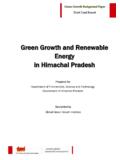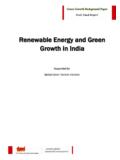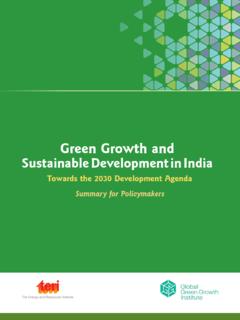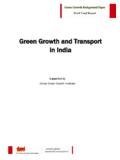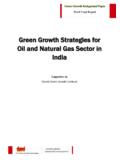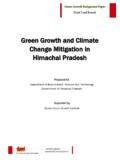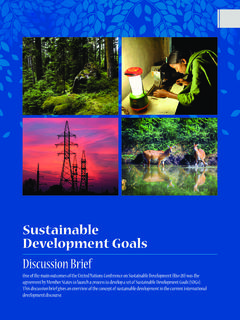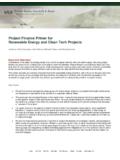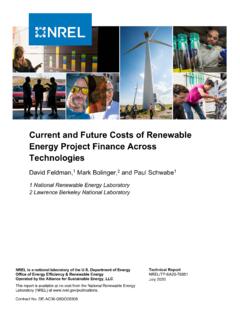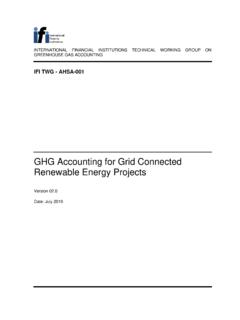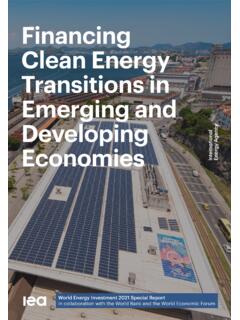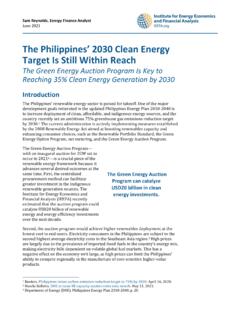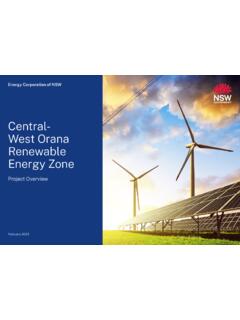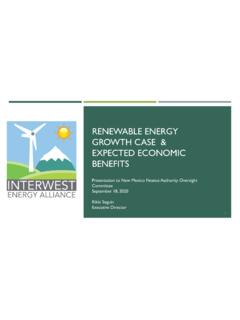Transcription of Renewable Energy and Green Growth in India
1 Renewable Energy and Green Growth in India Draft Final Report Supported by Global Green Growth Institute Renewable Energy and Green Growth in India ii The Energy and Resources Institute 2015 Suggested format for citation T E R I. 2015 Replace this line with the title of the report New Delhi: The Energy and Resources Institute. 26 pp. [Project Report No. _____] For more information Project Monitoring Cell T E R I Tel. 2468 2100 or 2468 2111 Darbari Seth Block E-mail IHC Complex, Lodhi Road Fax 2468 2144 or 2468 2145 New Delhi 110 003 Web i i India India +91 Delhi (0)11 Renewable Energy and Green Growth in India iii Table of Contents Contents INTRODUCTION.
2 1 STATUS REPORT .. 1 Grid Power/Installed Capacity .. 1 Off-Grid Renewable Energy /Power .. 5 Liquid Biofuels .. 6 Job creation .. 7 KEY BARRIERS .. 13 NATIONAL ROADMAP .. 15 Short Term Plan: By 15 Medium Term Plan: By 2030 .. 18 Long Term Plan: 2047 .. 20 BIBLIOGRAPHY .. 21 1 Introduction Renewable Energy has been an important component of India s Energy planning. The importance of Renewable Energy sources in the transition to a sustainable Energy base was recognized in the early 1970s. Modern Renewable Energy is being used increasingly in four distinct markets: power generation, heating and cooling, transport, and rural/off-grid Energy services.
3 The Ministry of New and Renewable Energy (MNRE) in India has been facilitating the implementation of broad spectrum programs including harnessing Renewable power, Renewable Energy for rural areas for lighting, cooking and motive power, use of Renewable Energy in urban, industrial and commercial applications and development of alternate fuels and applications. In addition, it supports research, design and development of new and Renewable Energy technologies, products and services. The approach for deployment of new and Renewable Energy systems focused on a mix of subsidy, fiscal incentives, preferential tariffs, market mechanism and affirmative action such as Renewable purchase obligations by way of legislation and policies.
4 Financial support has also been extended to research and development (R&D), information & publicity and other support programs. Renewable Energy plays an important role in the long-term Energy supply security, diversification of Energy mix, Energy access, environmental security and sustainability. Renewable Energy is bound to play an increasing role in future Energy systems. This chapter analyses central level policies and interventions for Renewable Energy applications and also recommends a set of guidelines to serve as a roadmap to accelerate the deployment of Renewable Energy technologies.
5 Status Report Grid Power/Installed Capacity Power generation from Renewable sources is on the rise in India , with the share of Renewable Energy in the country s total installed capacity rising from in 2008 to around 13% in 2014 (IREDA, 2014). India now has about GW of installed Renewable Energy capacity. Of these, wind is the largest contributor and stands at around GW of installed capacity making India the world s fifth largest wind Energy producer. Small hydro power ( GW), bio- Energy ( GW) and solar Energy (4 GW) constitute the remaining capacity (MNRE, 2015).
6 It has been reported that in terms of electricity generation, approximately 70 billion units per year is being generated from Renewable sources (MNRE, 2014). Figure 1 below shows the Renewable Energy mix in the total installed capacity in India . Renewable Energy and Green Growth in India 2 Figure 1: Share of renewables in total grid installed capacity Source: CEA-MNRE report Renewable Energy capacity addition has always kept pace with and exceeded the targets set by India s 5 year plans. Recently the government has announced a revision of targets for renewables by 2022.
7 Table 1 below shows installed capacities of the past along with the numbers for the targeted capacity in 2022. It is evident that this has been an unprecedented level of ambition of renewables in India . Table 1: Past and Targeted grid connected Renewable Energy capacities Renewable Energy Source Installed capacity by end of the 11th Plan (March 2012) Installed Capacity as on March 2015 Target as per 12th Plan (March 2017) Revised targets by 2022 Solar Power 941 3,383 10,941 100,000 Wind Power 17,352 22,645 32,352 60,000 Biomass Power 3,225 4,183 6,125 10,000 Small Hydro 3,395 4,025 5,495 5,000 Total 24,913 34,236 54,913 175,000 Source.
8 MNRE Coal -167,707 MW Gas - 22,962 MW Diesel - 993 MW Nuclear - 5,780 MW Hydro - 41,997 MW Wind - 23,762 MW Solar - 4,060 MW Small Hydro - 4,101 MW Bio Power - 4,418 MW Waste to Power - 127 MW Renewable Energy - 36,470 MW Renewable Energy and Green Growth in India 3 Solar The Jawaharlal Nehru National Solar Mission (JNNSM) was launched in 2010 after which the Indian SPV market has seen significant Growth . Grid connected SPV mainly consists of ground mounted, rooftop and distribution grid plants. With the provision of institutional arrangements, national and local enabling mechanisms, and targeted policies, including appropriate subsidies and financing arrangements, the total installed capacity rose from 40 MW in 2010 to 2686 MW as on 30 June 2014.
9 An aggregate capacity of 1686 MW was installed in JNNSM Phase I, and an additional capacity of 1000 MW has been added in Phase II of the programme (TERI, 2014-15). The total installed capacity of grid connected SPV as on June 2015 is MW (MNRE, 2015), which includes central and state level initiatives. In order to meet this target, the government is taking a number of measures which are listed below: Provision of Renewable purchase obligation (RPO) for solar power in the National Tariff Policy Grant of subsidy on off-grid applications and GBI facility for bundled power and Viability Gap Funding (VGF) for grid-connected solar power projects through various interventions announced from time to time Setting up ultra-mega solar power projects and solar parks, 1 MW solar parks on the banks of canals, and solar power driven agricultural pump sets for energizing 1 lakh pumps.
10 Concessional import duty/excise duty exemption for setting up of solar power plants, accelerated depreciation and tax holiday The first phase of the programme provided learning experiences to the government, such as reduction in tariffs is possible if the capacity to be allotted is high, experienced companies are interested in large projects and transmission and evacuation system is still a major issue. Apart from that, timely payment and assurance of continuity is essential from the point of view of the lender, the domestic manufacturing units need more R&D support since majority of the equipment are imported increasing the overall price.
